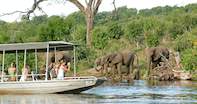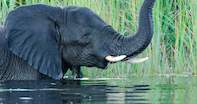
What Each Botswana Safari Region Has to Offer
Each Botswana safari trip destination has some different type of vegetation. This dictates the type of grazing and browsing animals that inhabit the area, and in turn, this will govern the prevalence of predator activity. Find out what each Botswana safari region has to offer.
Botswana is a land of unmatched beauty, plentiful in wildlife and rich in culture, giving this country its magical and dreamlike quality. Botswana encompasses prominent salt pans, diamond-rich deserts, lush flood plains teeming with animals and varied species.
Explore a diverse landscape from the North, with its spectacular bush-veld, grassy plains and crystal clear waterways of the Okavango Delta, to the deserts of the Kalahari regions.
Almost half of the country is allocated to Botswana National Parks, game reserves and private concessions, which offer superb game viewing opportunities, making this one of Southern Africa's top safari trip destinations.
Visit These Superb Botswana Safari Trip Destinations
- Chobe National Park
- Okavango Delta
- Moremi Reserve
- Makgadikgadi Pans
- Nxai Pan National Park
- Caprivi
- Linyanti Reserve
- Savute
- Maun
- Kasane
- Francistown
- Gaborone
Maun
Maun is the regional centre of Ngamiland (north-western Botswana) and is principally the service centre for the Botswana safari trip industry. It is relatively advanced, in African terms, with an international airport, two open-air shopping malls, banks and numerous hotels and lodges.
Regular flights arrive & depart from Johannesburg, Victoria Falls, Gaborone and Windhoek to Maun. The population of Maun and its environs is estimated at 40,000. The majority of safaris depart from Maun.
Chobe River
The lush Chobe riverfront is noted for the large concentrations of megafauna (elephant and buffalo) that gather on its banks in the dry season. Chobe in the dry season (Apr-Nov) is the only major source of water north of the Okavango. Hence game is attracted from great distances. A great time to visit Chobe on a Botswana safari trip.
The Chobe River itself originates, like the Okavango, in the highlands of Angola and eventually flows into the mighty Zambezi. Apart from elephant and buffalo, the Chobe National Park is noted for its namesake species of bushbuck, the puku, antelope and its birds. Its sunsets are also something to behold. Chobe Chilwero Lodge is located on the border of the Chobe National Park and offers the best views of the Chobe River.

Okavango Delta
The Okavango Delta is an area of unusual beauty and striking contrast - a must-see Botswana safari trip destination. Whilst the periphery is semi-arid, the Delta itself is a patchwork of cool clear streams, peatlands, back swamps and forested islands in the permanent swamps, and floodplains and ivory palm islands in the seasonal swamp.
In the dry winter season one of the most spectacular events in the natural world occurs, floodwaters that have traveled 1000 kilometers from the highlands of Angola infiltrate the delta inundating large areas causing a great concentration of wildlife.
Many species of wild animals, which move into the surrounding savannas during the wet season (summer months Dec-Feb), therefore, concentrate around the delta at this time. There are an estimated 9000 species of flora and fauna in residence in the delta throughout any one given year. The delta itself forms part of the Kalahari Basin, situated at the southern periphery of the Great Rift Valley (of East African fame), and covers an area of 22,000 square kilometres.
The delta can be divided into four regions; the panhandle, in the northern most reaches, the permanent swamps in the upper region, the seasonal swamps in the lower region and a large number of large landmasses, such as Chiefs Island, which occur as large islands or which extend into the delta from the surrounding mainland areas and are referred to as sand-veld tongues.

Savute
The Savute Channel has a fascinating history of flooding and drying up independently of good rainy seasons and flood levels elsewhere. The dead trees in the channel tell of a long non-flowing period. Savute has been the subject of numerous wildlife documentaries such as The Stolen River, Eternal Enemies and Patterns in The Grass to name a few. It is also home to small exhibits of bushmen rock art.
When is the best time to visit Savute on a Botswana safari trip? Savute is generally at its peak, game-wise, at the end of the rainy season (Mar-May) when large numbers of zebra and wildebeest move through the area from the Linyanti, further west, to the sweeter grasses on offer in the Mababe depression, to the south.
For the remainder of the year, there are generally excellent concentrations of plains game, particularly elephant, around the few waterholes in the area. It is not uncommon late in the dry season (Oct-Nov), to see elephant guarding the waterhole against the lion and plains game species.


 Caprivi is a protrusion in Namibia, that is adjacent to the northern border of Botswana. Access to Caprivi is by scenic flights and road tra...
Caprivi is a protrusion in Namibia, that is adjacent to the northern border of Botswana. Access to Caprivi is by scenic flights and road tra... Central Kalahari Game Reserve is located in the core of Botswana, and offers a spectacular game viewing opportunity for an African safari....
Central Kalahari Game Reserve is located in the core of Botswana, and offers a spectacular game viewing opportunity for an African safari.... Chobe National Park safari lodges and tours. Chobe National Park lies in north-east Botswana close to Kasane, the closest commercial airport...
Chobe National Park safari lodges and tours. Chobe National Park lies in north-east Botswana close to Kasane, the closest commercial airport... Francistown accommodation is offered at luxury game lodges and hotels. Francistown activities include sightseeing, cultural tours and many m...
Francistown accommodation is offered at luxury game lodges and hotels. Francistown activities include sightseeing, cultural tours and many m... Gaborone accommodation is offered at luxury hotels. Activities in Gaborone includes golfing, sightseeing, cultural tours and game drives at ...
Gaborone accommodation is offered at luxury hotels. Activities in Gaborone includes golfing, sightseeing, cultural tours and game drives at ... Kasane accommodation is offered at luxury safari lodges in Botswana. Activities in Kasane includes game drives, sightseeing, cultural tours ...
Kasane accommodation is offered at luxury safari lodges in Botswana. Activities in Kasane includes game drives, sightseeing, cultural tours ... Linyanti is a private reserve that borders the western section Chobe National Park, ideal for Botswana safari tours....
Linyanti is a private reserve that borders the western section Chobe National Park, ideal for Botswana safari tours.... Livingstone, the former capital of Zambias Southern Province, is located north of the magnificent Zambezi River....
Livingstone, the former capital of Zambias Southern Province, is located north of the magnificent Zambezi River.... Maun is located in the heart of the Ngamiland District and is the fifth largest town in Botswana. This Botswana town is renowned as the tour...
Maun is located in the heart of the Ngamiland District and is the fifth largest town in Botswana. This Botswana town is renowned as the tour... Guide to Mashatu Game Reserve in Botswana. Learn about the Wildlife of Mashatu Game Reserve, Best Time To Visit Mashatu, Mashatu Accommodati...
Guide to Mashatu Game Reserve in Botswana. Learn about the Wildlife of Mashatu Game Reserve, Best Time To Visit Mashatu, Mashatu Accommodati... Makgadikgadi Pans is a salt pan located in the northernmost section of Botswana, right in the middle of the dry savanna plains....
Makgadikgadi Pans is a salt pan located in the northernmost section of Botswana, right in the middle of the dry savanna plains.... Moremi Game Reserve accommodation is offered in luxury safari lodges in Botswana. Activities in Moremi Reserve include game drives, bush wal...
Moremi Game Reserve accommodation is offered in luxury safari lodges in Botswana. Activities in Moremi Reserve include game drives, bush wal... Nxai Pan National Park is a conservancy located in the north-eastern section of Botswana, that comprises of the Nxai Pan....
Nxai Pan National Park is a conservancy located in the north-eastern section of Botswana, that comprises of the Nxai Pan.... Okavango Delta is a large inland delta and is one of the most popular Botswana safari tour destinations....
Okavango Delta is a large inland delta and is one of the most popular Botswana safari tour destinations.... Savute is tucked away within the spectacular Chobe National Park in Botswana, and stretches all along the northern boundaries of the park...
Savute is tucked away within the spectacular Chobe National Park in Botswana, and stretches all along the northern boundaries of the park... The Victoria Falls is a spectacular waterfall located on the border of Zimbabwe and Zambia. The falls is also in close proximity to Botswana...
The Victoria Falls is a spectacular waterfall located on the border of Zimbabwe and Zambia. The falls is also in close proximity to Botswana...